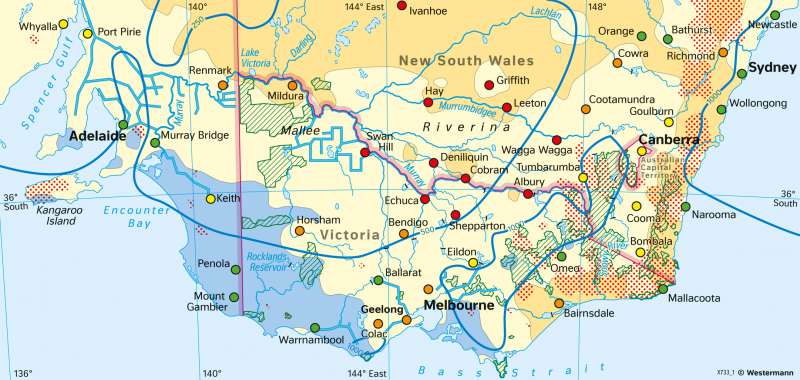South-East Australia - Droughts and bushfires in 2019/2020 ('Black Summer')
Hazardous environment
978-3-14-100890-6 | Page 166 | Ill. 2

Overview
South-East Australia is one of the most fire- and drought-prone regions in the world.
Bushfires in South East Australia
Bushfires have shaped South-East Australia’s vegetation over millions of years. They usually occur in the summer months, and are driven by high temperatures, dry conditions and strong winds. The vegetation in the bushlands is adapted to the fires: Eucalyptus trees, e.g., have an extensive root system which is protected from fire. Under the bark, buds start sprouting when the tree is under stress, so that even burnt down trees can survive. Furthermore, the seeds are surrounded by hard capsules which can withstand high temperatures.
The Black Summer bushfire 2019/2020
The extent of bushfires has increased in the last decades: A recent example happened in the summer of 2019/2020 when Australia experienced an unusually intense bushfire season, commonly referred to as the Black Summer. The fires started in June 2019, two months before the bushfire season usually starts. Until March 2020, the area affected had grown to about 170,000 km². The fires were mainly in eastern Victoria and eastern New South Wales. They included several national parks on the coast and in the Great Dividing Range as well.
The huge extent of the Black Summer bushfires is due to two conditions: 2019 was the warmest and driest year in the Australian weather records. The summer was marked by temperatures of over 40°C and in some regions there was about 40% less rainfall than in other years. Due to both factors the fires could spread easily and were very difficult or impossible to control.
Droughts in South East Australia
Besides the regions affected by bushfires the whole of South-East Australia is prone to droughts. This is due to the same factors that cause the fires. In the southern part of New South Wales, e.g., which only receives between 250 and 500 mm of rainfall, the precipitation in 2016-2019 was only 50-70% of the long-term-average. The summer temperatures however can reach up to 44°C. Consequently, agriculture in Southern New South Wales suffers from water shortage. This brings about economic problems as the region is one of Australis’s centres for crop and cattle farming.
Author:
Christoph Zwissler
The Black Summer bushfire 2019/2020
The extent of bushfires has increased in the last decades: A recent example happened in the summer of 2019/2020 when Australia experienced an unusually intense bushfire season, commonly referred to as the Black Summer. The fires started in June 2019, two months before the bushfire season usually starts. Until March 2020, the area affected had grown to about 170,000 km². The fires were mainly in eastern Victoria and eastern New South Wales. They included several national parks on the coast and in the Great Dividing Range as well.
The huge extent of the Black Summer bushfires is due to two conditions: 2019 was the warmest and driest year in the Australian weather records. The summer was marked by temperatures of over 40°C and in some regions there was about 40 % less rainfall than in other years. Due to both factors the fires could spread easily and were very difficult or impossible to control.
Effects of the Black summer bushfires
The effects of the Black Summer bushfires were immense. 34 people died and about 6,000 buildings were destroyed. Large areas of bushland were burnt down. Several million animals were killed and some endangered species are extinct now. The smoke polluted the air in western and southern Australia and distributed as far as Argentina. The total economic costs of the fires are estimated to be around 63 billion €. Among them are costs for damages and economic losses, for example in the tourism sector.
Droughts in South East Australia
Besides the regions affected by bushfires the whole of South-East Australia is prone to droughts. This is due to the same factors that cause the fires. In the southern part of New South Wales, e.g., which only receives between 250 and 500 mm of rainfall, the precipitation in 2016-2019 was only 50-70 % of the long-term-average. The summer temperatures however can reach up to 44°C. Consequently, agriculture in Southern New South Wales suffers from water shortage. This brings about economic problems as the region is one of Australis’s centres for crop and cattle farming.




